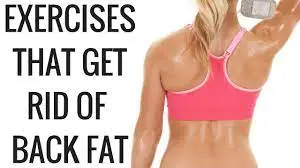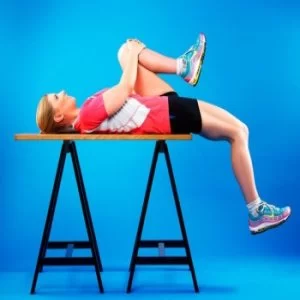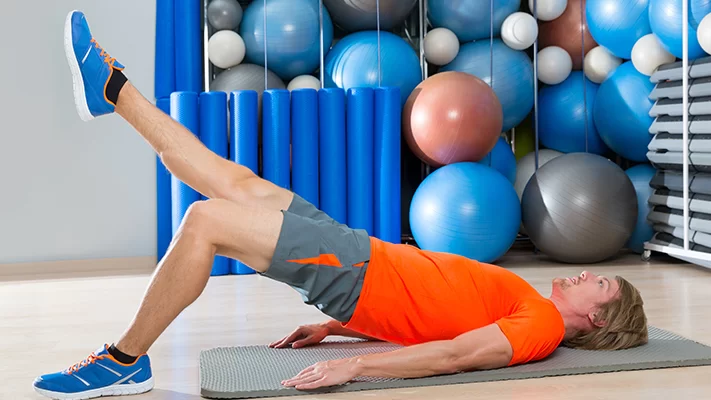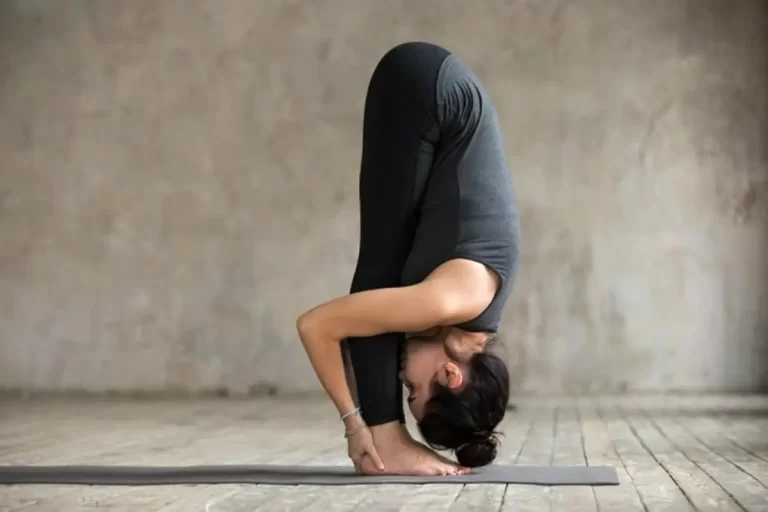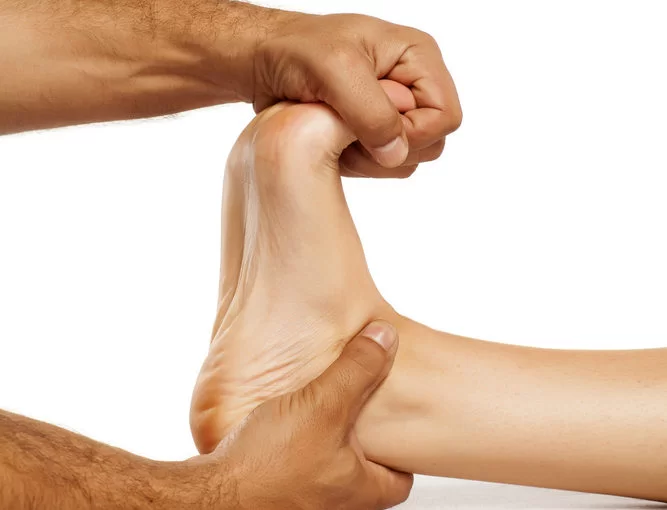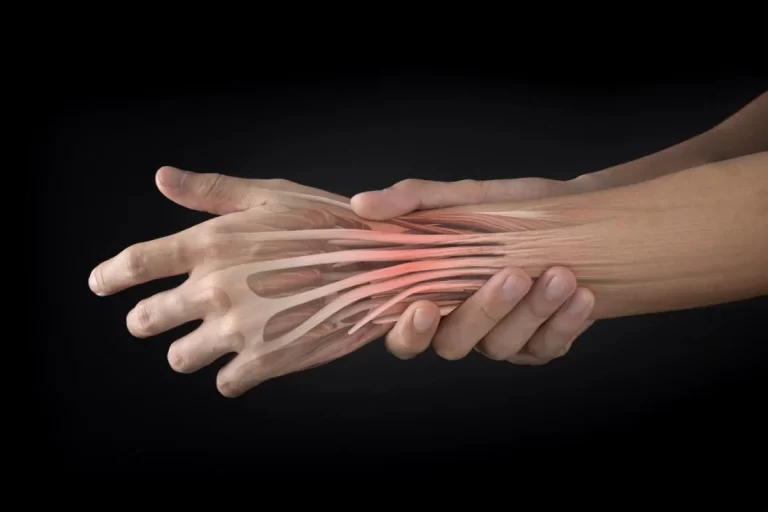Best Exercises for Back Fat: Burn Fat and Tone Your Muscles
When you consume more calories than your body typically expends, the excess is stored in the form of fat. The distribution of body fat is influenced by the levels of sex hormones in your body. Common fat storage areas include the buttocks, belly, thighs, arms, and back. Burning fat requires a deliberate effort, but it’s important to note that spot reduction is not possible. Therefore, exercises targeting back fat focus on various aspects of muscle development.
What leads to the accumulation of back fat?
Back fat can be influenced by several factors. A lack of cardiovascular exercise or a sedentary lifestyle can contribute to the development of back fat. Additionally, a diet high in sodium or sugar can lead to inflammation in the body, causing back fat and bloating to become more noticeable.
Poor posture and ill-fitting clothing can also make your back appear bulgy or uneven.
However, it’s essential to understand that genetics often play a significant role in determining where excess weight is deposited on your body. This means that the presence of back fat can vary based on factors such as:
- The life phase you are currently experiencing.
- Your overall body weight.
- Your height.
- Your level of physical activity.
Type of Back Fat
- Upper Back Fat:
- Upper back fat, often informally known as “bra bulge” or “back rolls,” is a common concern for many individuals. This type of back fat tends to accumulate just below the bra line and extends across the upper back. It becomes noticeable, particularly when wearing tight-fitting clothing or swimsuits, leading to feelings of self-consciousness.
- Women, especially those with larger breasts, tend to have more noticeable upper back fat, while it can affect anyone of any gender. Not only does losing upper back fat improve your appearance overall, but it also helps with posture and comfort when wearing different types of apparel.
- Lower Back Fat:
- Lower back fat presents another challenging area to address. This kind of back fat often develops above the hips in the lumbar region. When excess fat builds up in this area, it can create a “muffin top” appearance, especially when wearing low-rise pants, skirts, or form-fitting attire.
- Lower back fat can be particularly stubborn, affecting the fit and comfort of clothing. People can have a smoother, more toned lower back by targeting this area with targeted exercises and using a thorough fat reduction strategy.
Factors Contributing to the Presence of Back Fat
Back fat, whether it appears in the upper or lower regions, can be attributed to a combination of influential factors. Recognizing and comprehending these contributing elements is vital for devising an effective strategy to reduce or eliminate back fat. Here are the key factors involved:
- Diet and Nutrition:
- Poor dietary choices play a substantial role in the accumulation of back fat. The consumption of a diet high in calories, saturated fats, sugars, and processed foods can result in weight gain, often manifested as excess fat in various body areas, including the back. A poor body composition might also result from a diet lacking in vital nutrients.
- Lack of Physical Activity:
- Maintaining a sedentary lifestyle and engaging in insufficient physical activity can lead to weakened back muscles and overall body fat buildup. Underutilized back muscles lose their tone, creating a conducive environment for fat accumulation. Regular exercise is indispensable for preserving a healthy body composition and preventing the development of back fat.
- Genetics:
- Genetic factors play a significant role in determining an individual’s body shape and their propensity to store excess fat in particular areas, be it the upper or lower back. Some individuals may have a genetic predisposition that makes it more challenging to target and reduce fat through diet and exercise alone.
- Aging:
- As people age, their metabolism naturally decelerates, which can lead to weight gain. Furthermore, age-related hormonal changes can influence the distribution of fat, potentially causing it to accumulate in the back region. Maintaining a healthy lifestyle and adhering to a consistent exercise routine becomes increasingly critical as one ages to counteract these effects.
- Hormonal Changes:
- Hormonal imbalances, such as those associated with thyroid function or menopause, can impact fat storage patterns within the body. Hormones play a pivotal role in regulating metabolism and fat distribution, and disruptions in hormone levels can contribute to the development of back fat.
Cardiovascular Exercises to Combat Back Fat
Cardiovascular exercises, commonly known as cardio workouts, are an integral part of any effective strategy to reduce back fat. These workouts elevate your heart rate, torch calories, and contribute to overall fat loss, including the troublesome back fat. In this discussion, we’ll delve into the advantages of cardio for tackling back fat and explore some of the top cardio exercises to incorporate into your fitness regimen.
Benefits of Cardiovascular Exercises:
- Calorie Burn: Cardio workouts ramp up your calorie expenditure, helping you establish the crucial calorie deficit necessary for weight loss. Shedding fat entails burning more calories than you consume, and cardio exercises play a pivotal role in achieving this balance.
- Fat Loss: Cardio workouts primarily target stored fat as an energy source. Consistent cardio routines encourage your body to tap into fat reserves, including those in the back region, for energy, resulting in fat reduction.
- Overall Health: Cardiovascular exercises enhance heart health, boost circulation, and increase lung capacity. They also aid in managing cholesterol levels, mitigating the risk of chronic diseases such as heart disease and diabetes, and elevating your overall fitness level.
- Stress Reduction: Cardio activities release endorphins, innate feel-good hormones of the body. This can alleviate stress and enhance your mental well-being, indirectly supporting healthier eating habits and more effective weight management.
Top Cardio Exercises for Back Fat Reduction:
- Running or Jogging: Running or jogging stands as an excellent means to burn calories and target overall body fat, including back fat. It demands minimal equipment and can be done outdoors or on a treadmill.
- Cycling: Whether on a stationary bike or in the great outdoors, cycling engages the leg muscles and burns calories efficiently. It’s a low-impact choice suitable for individuals of varying fitness levels.
- Swimming: Swimming offers a full-body workout engaging muscles across the back, shoulders, and arms. It’s particularly effective for those aiming to reduce upper back fat.
- Jump Rope: Jumping rope is a high-intensity cardiovascular exercise involving the entire body. It’s an excellent option for rapid calorie burning and can be executed almost anywhere.
- Elliptical Trainer: The elliptical trainer delivers a low-impact, full-body workout. It’s gentle on the joints while still delivering an efficient calorie burn.
- Dancing: Be it in the form of Zumba, hip-hop, or salsa, dancing provides an enjoyable way to elevate your heart rate and incinerate calories. Dancing can also enhance coordination and flexibility.
- High-Intensity Interval Training (HIIT): HIIT workouts feature brief bursts of intense activity followed by short rest intervals. This style of training is exceptionally effective for calorie consumption and can be tailored to include exercises targeting the back muscles.
Strength Training Exercises for Targeting Back Fat
In the pursuit of reducing back fat, strength training stands as a pivotal component. While cardiovascular workouts aid in calorie burning and overall fat loss, strength training focuses on sculpting and toning the back muscles. Here, we’ll emphasize the significance of fortifying these muscles and introduce some top-notch strength training exercises to incorporate into your fitness routine.
The Significance of Building Back Muscles:
- Increased Metabolism: Muscle tissue is inherently more metabolically active than fat tissue, meaning it burns more calories even at rest. By cultivating lean muscle in your back, you can elevate your metabolism, facilitating weight management and gradual back fat reduction.
- Improved Posture: Robust back muscles contribute to better posture, allowing you to maintain an upright position effortlessly. This not only enhances your overall appearance but also minimizes the visibility of back rolls and bulges.
- Enhanced Strength and Functionality: Strengthening your back muscles augments your capacity to perform daily tasks and other exercises efficiently. It can also reduce the risk of back pain and injuries, fostering better functional fitness.
- Toned Appearance: The development of a well-defined back through strength training can result in a sculpted and toned look. This boost in confidence can make you feel at ease in a variety of clothing styles.
Top Back-Strengthening Exercises:
- Pull-Ups: Pull-ups rank among the most potent exercises for targeting the upper back and fostering strength. They engage the latissimus dorsi (lats), the largest muscles in the back.
- Rows: Various rowing exercises, such as bent-over rows, seated cable rows, and single-arm dumbbell rows, work the middle and upper back muscles, aiding in posture enhancement and back fat reduction.
- Lat Pulldowns: Lat pulldowns zero in on the latissimus dorsi and serve as an excellent alternative for those unable to perform pull-ups initially. They are performed utilizing a cable machine/resistance bands.
- Deadlifts: Deadlifts are a compound exercise that activates multiple muscle groups, including the lower back. They contribute to strengthening the entire back and enhancing overall stability.
- Face Pulls: Face pulls effectively target the rear deltoids and upper traps, contributing to a more defined upper back and shoulders.
- T-Bar Rows: T-bar rows concentrate on the middle back and lats and can be executed using a T-bar row machine or a barbell with a landmine attachment.
- Dumbbell Shrugs: Dumbbell shrugs predominantly work the trapezius muscles located in the upper back and neck area. Developing strong traps can enhance the upper back’s appearance.
- Chin-Ups: Chin-ups, a variation of pull-ups that engage the biceps more prominently, continue to target the upper back and can be included in your routine to introduce variety.
Core Exercises for Targeting Back Fat and Enhancing Overall Fitness
In conjunction with cardiovascular and strength training routines, directing your attention toward your core muscles is a vital aspect of a holistic approach to back fat reduction. A strong core provides invaluable stability and support to your spine, thereby improving posture and contributing to a more sculpted and lean appearance in the back region. Below, we delve into the pivotal role of a robust core in back fat reduction and introduce effective core exercises to incorporate into your fitness regimen.
The Role of a Strong Core in Back Fat Reduction:
- Posture Improvement: A robust core aids in maintaining proper posture, reducing the visibility of back rolls and promoting an upright stance. Engaging your core muscles facilitates standing tall and aligning your spine correctly.
- Stability and Balance: A well-developed core enhances stability and balance, essential for executing various exercises with precision. This not only helps prevent injuries but also amplifies the effectiveness of your workouts.
- Full-Body Engagement: Core muscles interconnect with the back muscles, playing a significant role in numerous movements, including those targeting the back. Strengthening your core can elevate your overall performance in exercises that engage the back muscles.
- Overall Toning: Strong core muscles contribute to a toned and sculpted midsection, which complements the appearance of a leaner back.
Effective Core Exercises:
- Planks: Planks are a time-honored core exercise engaging the entire core, including the rectus abdominis, transverse abdominis, obliques, and lower back muscles. Assume a plank position with your forearms and toes on the ground, maintaining a straight body line.
- Russian Twists: Russian twists target the oblique muscles, crucial for core stability. Sit on the floor with bent knees and raised feet, holding a weight or medicine ball. Bend your torso to both sides while maintaining your core encountered.
- Bicycle Crunches: Bicycle crunches effectively work the rectus abdominis and obliques. Supine lying on your back, bring your shoulders off the floor & lift your left elbow toward your right knee while extending your left leg. Alternate sides in a pedaling motion.
- Leg Raises: Leg lifts especially focus on the lower abs. Lie on your back with your hands under your hips and lift your legs off the ground while keeping them straight. Decrease them back down without allowing them to touch the floor.
- Hollow Holds: The isometric workout known as the “hollow hold” works the entire core. Lay on your back, raise your shoulders and legs off the floor, and maintain the position by contracting your abs.
- Side Planks: Side planks focus on the obliques. Lift your hips off the floor while lying on your side with your elbow precisely under your shoulder. Your body should now be in a straight line from head to heels.
- Mountain Climbers: A dynamic core exercise that increases heart rate is mountain climbing. Assume a plank position and alternately bring your knees toward your chest while actively engaging your core.
Incorporating Stretching and Flexibility for Back Fat Reduction
Stretching and flexibility exercises are frequently underestimated in the quest to diminish back fat, yet they play a pivotal role in maintaining a healthy and functional back. By enhancing flexibility and mobility in the back and its surrounding muscles, you can not only elevate your overall fitness but also contribute to a more toned and sleek appearance. In this section, we’ll delve into the manifold advantages of stretching and flexibility exercises and furnish you with key stretches to integrate into your fitness routine.
The Benefits of Stretching for Back Fat Reduction:
- Improved Range of Motion: Stretching enhances the flexibility of the muscles and joints in the back and adjacent regions. This expanded range of motion makes it easier to execute exercises accurately and mitigates the risk of injury.
- Pain relief: Stretching can relieve stress and stiffness in the back muscles, which lowers the risk of back pain and discomfort, which is frequently associated with back fat. often accompanies back fat.
- Posture Enhancement: Stretching exercises targeting the chest, shoulders, and upper back can counteract the effects of poor posture, which can contribute to the appearance of back rolls.
- Stress Reduction: Stretching serves as a calming and mindful practice, reducing stress and fostering overall well-being. Stress can be a contributing factor to weight gain and back fat, rendering stress reduction pivotal in your fitness journey.
Key Stretches for the Back:
- Cat-Cow Stretch: Start on all fours and alternately arch your back (cow) and round it (cat). This stretch enhances spinal flexibility and relieves tension in the back.
- Child’s Pose: Begin by kneeling, then sit back onto your heels with your arms stretched forward. This stretch lengthens the lower back and provides relief for back discomfort.
- Cobra Stretch: Lie face down, place your hands under your shoulders, and gently lift your upper body off the ground. The lower back is the focus of this stretch, which also helps with posture.
- Child’s Pose Twist: From the child’s pose position, extend one arm to the side and twist your torso in that direction, experiencing a stretch in the lower back and obliques.
- Seated Forward Bend: Sit with your legs out in front of you and bend forward at the waist to touch your toes or ankles. The hamstrings and lower back are the focus of this stretch.
- Spinal Twist: Lie on your back and, keeping your shoulders firmly planted, bend and lower your knees to one side. This stretch can release tension and is great for the lower back.
- Upper Back Stretch: Clasp your hands in front of you, round your upper back, and extend your arms forward while tucking your chin. This stretch focuses on the upper back and shoulders.
- Wall Angels: While standing with your back to a wall, make snow angel-like motions along the wall while raising your arms to shoulder height. This stretch enhances shoulder mobility and upper back flexibility.
How to Eliminate Back Fat?
To bid farewell to back fat, it’s essential to focus on overall fat reduction. Achieving this entails adopting a nutritious diet and incorporating a combination of cardio and toning exercises into your routine.
Several factors, such as genetics, diet, and lifestyle choices, influence where your body stores fat. Unfortunately, everyday movements like walking and carrying groceries tend to engage the front of your arms and chest, making it challenging to target back muscles and reduce back fat directly.
The concept of “spot-treating” fat in specific body areas through particular exercises is a misconception. The key to shedding back fat lies in overall fat loss.
Here’s a comprehensive approach to tackle back fat:
- Caloric Deficit: Initiate your journey by creating a caloric deficit. This implies that you expend more calories than you take in. A caloric deficit doesn’t have to be drastic; small changes can yield results over time. Reducing your daily caloric intake by 300 to 500 calories is a good starting point, resulting in a loss of about one to two pounds per week.
- Nutrition: A significant aspect of creating a caloric deficit is modifying your diet. Begin by cutting back on calorie-dense, low-nutrition foods. Eliminate sugary drinks, processed grains, and foods with excessive artificial preservatives. Opt for a diet rich in fiber and low in sodium to help reduce excess fat and water weight, which might be stored in your back area.
- Weight-loss-friendly foods include:
- Avocados
- Hard-boiled eggs
- Leafy greens
- Broccoli and cauliflower
- Sweet potatoes
- Salmon and tuna
- Lean chicken breast
- Weight-loss-friendly foods include:
- Exercise Routine: Complement your dietary changes with an exercise regimen targeting both upper and lower back muscles. Cardiovascular workouts, especially high-intensity interval exercises (HIIT), can help accelerate fat loss.
- Strength Training: Integrate strength training exercises that work your back muscles into your routine. Exercises like pull-ups, rows, lat pulldowns, deadlifts, and more can help you tone and strengthen your back.
- Consistency: Consistency is key. Stick to your diet and exercise plan, and monitor your progress over time. Plan your ritual as required to continue seeing outcomes.
Effective Exercises for Addressing Back Fat
It’s crucial to recognize a fundamental truth when it comes to eliminating fat:
Exercise alone will not directly eradicate fat from specific areas.
Research has consistently shown that spot-reducing fat in targeted regions like the back, abs, or legs is not feasible. Fat loss hinges primarily on two key factors:
- Dietary Choices: Your calorie intake plays a pivotal role in fat loss. Consuming an excessive number of calories will impede your fat loss progress. While exercise aids in burning calories, it cannot compensate for a poor diet. Thus, a focus on dietary choices is paramount for successful fat loss.
- Genetics: Every individual possesses a unique genetic makeup that dictates their fat storage patterns. As you embark on a fat loss journey, you may or may not lose fat from the specific areas you desire initially.
To achieve fat loss in any part of your body, you must combine dietary modifications and exercise.
A recent study from 2021 underscores the significance of these driving factors for fat loss.
Now, let’s delve into the exercises that can help you enhance lean muscle tone in your back. While these exercises contribute to overall back strength and appearance, it’s essential to recognize that they alone may not eliminate fat in specific areas, such as the “bra strap” region.
The Best Exercises to Target Back Muscles:
- Pull-Ups: Pull-ups are excellent for strengthening the upper back, particularly the latissimus dorsi (lats).
- Rows: Incorporate various rowing exercises like bent-over rows, seated cable rows, and single-arm dumbbell rows to work the middle and upper back muscles.
- Lat Pulldowns: Lat pulldowns target the latissimus dorsi and offer an alternative for those unable to perform pull-ups initially.
- Deadlifts: Deadlifts are compound exercises engaging multiple muscle groups, including the lower back, contributing to overall back strength.
- Face Pulls: Face pulls focus on the rear deltoids and upper traps, which can enhance the appearance of the upper back and shoulders.
- T-Bar Rows: T-bar rows emphasize the middle back and lats, promoting back strength and definition.
- Dumbbell Shrugs: Dumbbell shrugs primarily target the trapezius muscles, located in the upper back and neck area, contributing to an improved upper back appearance.
- Chin-Ups: Chin-ups, a variation of pull-ups, are effective for the upper back and biceps.
While these exercises bolster your back muscles, remember that an overall commitment to dietary changes and a holistic exercise regimen is key to achieving your fat loss goals. Patience and persistence are crucial as you work toward a healthier and more toned back.
Effective Back Exercises Without Equipment (Ideal for Beginners)
The good news is that these exercises are perfect for beginners with little to no prior experience. Let’s explore a set of exercises that can help you target your back muscles without the need for any equipment.
Exercises On Your Stomach:

- Prone Lat Pull Down:
- Start with prone lying face down on the floor.
- Extend your arms overhead with your thumbs pointing towards the ceiling.
- Retract your shoulder blades (scapulae) and pull your elbows down alongside your body, as if you were placing your elbows in your back pockets.
- Maintain this contraction for 1 second & then back to the starting pose.
- Keep your glutes engaged throughout and avoid arching your lower back.
- Aim for 12-15 repetitions per set.
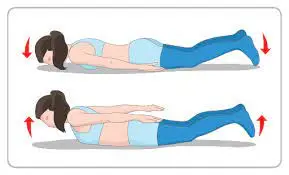
- Prone Thoracic Extension:
- Lie face down on the base with your hands grabbed behind your head.
- Squeeze your glutes and engage your core.
- Lift your head and upper chest off the floor, focusing on arching at the upper back only.
- Maintain this pose for 2-3 seconds before dropping back down.
- Ensure that your lower back remains flat without any arch.
- If your range of motion is limited initially, that’s perfectly fine; work within your current abilities.
- Target 10-12 repetitions per set.
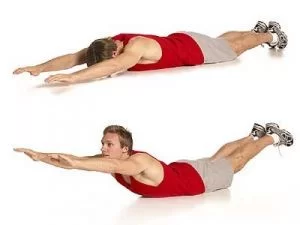
- Superwoman:
- Assume a prone position on the floor with your arms extended overhead.
- Brace your core and squeeze your glutes.
- Lift both arms straight up into the air while simultaneously raising your feet off the floor.
- Keep your elbows & knees straight forward, and maintain this pose for 1-2 seconds.
- Gradually back to the beginning position & repeat.
- Aim for 10-12 repetitions per set.

- YTW:
- Lie face down on the floor with your arms extended overhead, thumbs facing the ceiling.
- Begin by creating a “Y” shape with your arms, similar to the YMCA song.
- Lift your arms off the floor by contracting your upper back muscles and hold for 2 seconds.
- Next, move your arms straight out to the sides, forming a “T” position, and again, lift your arms off the floor (thumbs facing up) for 2 seconds.
- Finally, bend your elbows to your sides, creating a “W” shape, and hold this contraction for 2 seconds.
- Perform 6-8 repetitions in each position per set.
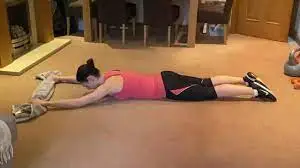
- Towel Slide Pulldowns:
- Lie face down on the ground while holding any ordinary towel overhead.
- Brace your core and activate your glutes.
- Arch your upper back and slide the towel down towards your chest by squeezing your shoulder blades together.
- Slowly return the towel to the overhead position by sliding it along the floor.
- Repeat this motion.
- Aim for 12-15 repetitions in each position per set.
Exercises While Lying on Your Back:
Let’s continue with back exercises that can be performed while lying on your back. These exercises are beneficial and can be particularly effective for strengthening your back muscles.
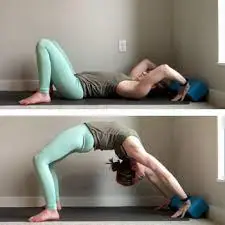
- Bridge Press Ups:
- Supine lying on your back with your knees flexed & feet flat on the ground.
- Position your hands palm down by your head, fingers pointing towards your heels.
- Engage your glutes and brace your core before each repetition.
- Press your hands down as you lift your buttocks off the ground, striving to straighten your elbows fully at the top.
- Maintain your body and return to the beginning pose.
- Aim for 10-12 repetitions per set.
- Supine Bodyweight Flys:
- Supine lying position with your knees flexed & feet flat on the ground.
- Extend your arms directly out to your sides with straight elbows and thumbs pointing upward.
- Press your fists into the ground to lift your upper back off the floor.
- Maintain this contraction for 2-3 seconds before back to normal.
- Repeat this motion.
- Target 12-15 repetitions per set.
Exercises on Your Hands or Knees (Quadruped Position):
Now, let’s explore exercises in the quadruped position, which can help strengthen your back muscles and improve your core stability.
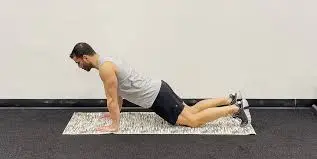
- Quadruped Straight-Arm Pulldowns:
- Start in a quadruped pose (on your hands and knees).
- Place a towel under both your knees.
- Extend your hands as far forward as possible, palms flat on the floor with straight elbows.
- Engage your core and pull your body forward by pressing your hands back and down on the floor.
- Imagine trying to touch your knees with your hands without lifting your palms or bending your elbows.
- Your lower body should slide along the floor toward your hands.
- Back your hands to the beginning pose & repeat.
- Aim for 6-8 repetitions per set.
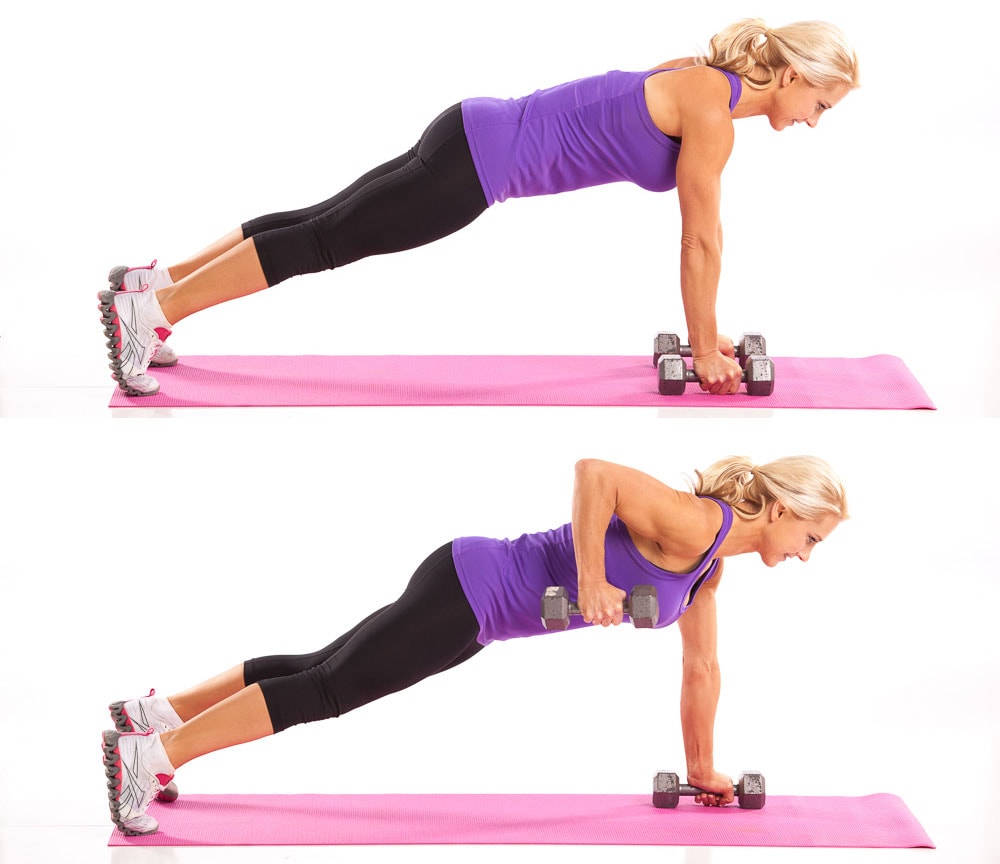
- Plank Rows (AKA Renegade Rows):
- Get into a plank pose with your feet together & your hands shoulder-width apart.
- Maintain a tight core and engaged glutes.
- Lift one hand (use a dumbbell if desired) and bring your elbow up toward your chest in a straight line.
- Rotate your upper body, raising that hand toward the ceiling.
- Hold this position for 1-2 seconds before returning to the plank.
- If this exercise is too challenging, you can perform it from your knees.
- Target 8-10 repetitions per side.
Standing Back Exercises:
In this section, we’ll focus on standing back exercises that can help you strengthen your back muscles. These exercises are versatile and can be performed virtually anywhere.
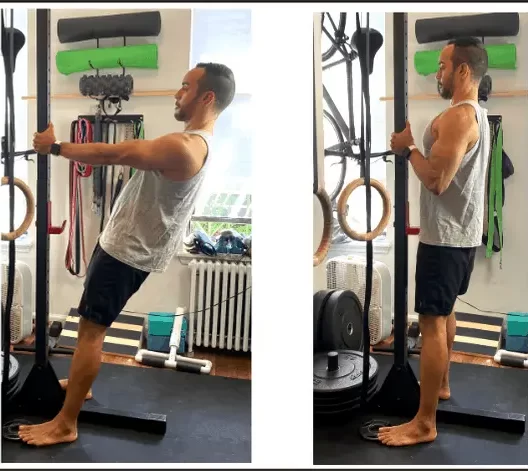
- Wall Pulls:
- Locate a sturdy door frame or pole that you can use for support.
- Hold the door frame with both hands & extend your elbows.
- The closer you place your feet to the frame, the more challenging the exercise.
- Pull yourself toward the door frame until your chest touches it.
- Hold this position for 2 seconds, emphasizing the squeeze in your back muscles.
- Slowly extend your elbows and repeat.
- Aim for 12-15 repetitions per set.
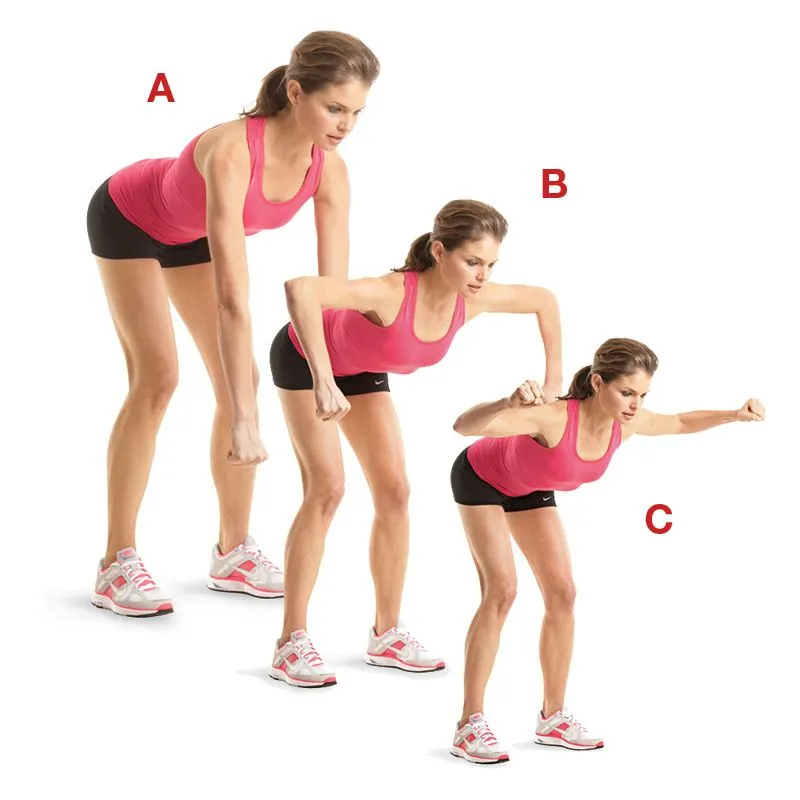
- Bent Over W’s:
- Stand with your feet shoulder-width apart and hinge at your waist, bending until your back is parallel to the floor.
- Hold a neutral spine without arching/curving.
- Slightly bend your knees.
- Flex your elbows & keep them near to your sides.
- Laterally turn your arms to make a ‘W’ shape with it.
- Squeeze your upper back muscles and hold for 3 seconds before releasing.
- Aim for 12-15 repetitions per set.

- Scapular Wall Slides:
- Stand with your back against a wall, making contact with your head, upper back, lower back, and buttocks.
- Keep your lower back flat against the wall throughout.
- Position the backs of your hands against the wall by your head.
- Slide your arms up the wall as slowly as possible while maintaining contact with the wall.
- Try not to let your elbows, wrists, or hands leave the wall.
- Reverse the movement slowly and repeat.
- Target 8-10 repetitions per set.
Back Exercises with a Resistance Band:
Using a resistance band can add variety and challenge to your back exercises. These exercises are effective in targeting various back muscles.
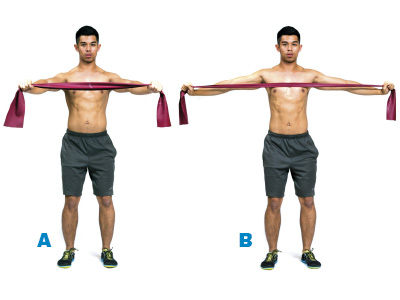
- Band Pull Aparts:
- Start with the lightest resistance band.
- Hold both ends of the band with palms facing up toward the ceiling.
- Pull the band apart without bending your elbows, until it touches your chest.
- Squeeze your upper back muscles and hold the contraction.
- Slowly release and repeat.
- Aim for 12-15 repetitions per set.

- Band Seated Rows:
- Sit on the ground with your legs straightened in front of you.
- Place the middle of a band around your feet and grasp both ends.
- Keep your back straight without rounding.
- Brace your core and pull the band toward your waistline.
- Focus on squeezing your upper back muscles together and holding the contraction.
- Slowly release and repeat.
- Target 12-15 repetitions per set.
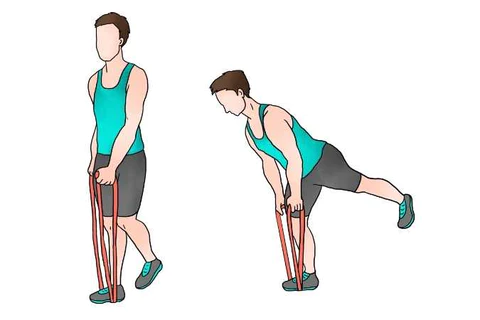
- Deadlifts:
- Stand in the middle of the band, ensuring equal length on both sides of your feet.
- Bend down and grip both loops with palms facing each other.
- Maintain a flat back and hinge at your hips to feel tension in your hamstrings.
- Engage your core & stand up tall by extending your hips & knees.
- Keep your back flat throughout and your chin down.
- Squeeze your glutes to finish the lift.
- Lower slowly.
- Perform 10-12 repetitions per set.
Additional Tips and Strategies for Reducing Back Fat
- Incorporate Yoga: You don’t need to be a yoga enthusiast to benefit from its positive effects on your body. You can easily integrate yoga into your daily routine by following online tutorials or using a yoga app. Practicing yoga can enhance your flexibility, improve posture, and contribute to overall physical fitness.
- Quality Sleep: Adequate and quality sleep is essential for maintaining a healthy weight. Research has shown a connection between poor sleep quality and obesity in various age groups, including adolescents. Ensure you get enough rest as it plays a vital role in supporting your metabolism and overall well-being.
- Maintain Good Posture: Spending long hours hunched over a laptop or desk can lead to poor posture, which may contribute to back fat and discomfort. Focus on maintaining proper posture throughout the day. This will help distribute weight more evenly across your body, leading to a slimmer appearance around the core and back.
- Hydration: Drinking enough water is crucial for overall health and can indirectly aid in weight management. Staying well-hydrated helps regulate bodily functions, including metabolism and appetite control.
- Balanced Diet: Make gradual changes to your eating habits by incorporating more whole, nutrient-dense foods into your diet. Reducing the consumption of processed and high-calorie foods can contribute to weight loss and a healthier back.
- Stress Management: Chronic stress can cause weight gain and contain back fat. Implement stress-reduction techniques such as meditation, deep breathing exercises, or mindfulness to help manage stress levels effectively.
- Cardiovascular Exercise: In addition to strength training, incorporate regular cardiovascular exercises like brisk walking, running, swimming, or cycling into your routine. Cardio activities help burn calories & contribute to overall fat loss in the body.
- Consult a Professional: If you’re struggling to achieve your back fat reduction goals, consider consulting with a fitness trainer or nutritionist. They can provide personalized guidance and create a tailored plan to meet your specific needs and objectives.
Effective Lifestyle Changes for Weight Loss:
- Incorporate More Walking: Increasing your daily step count can significantly contribute to calorie expenditure. Instead of driving short distances, consider walking to nearby destinations, such as dropping your child off at school or going to the local coffee shop. This simple change can help burn extra calories and support your weight loss goals.
- Quit Smoking: If you’re a smoker, quitting is not only beneficial for your overall health but can also aid in weight management. Smoking cessation can be challenging, but seeking guidance from a healthcare professional can help you create a personalized plan to quit successfully.
- Focus on Posture: Practicing good posture helps minimize the appearance of back fat and strengthens your back muscles. Correcting your posture while sitting or standing engages your core and back muscles, providing a subtle workout throughout the day. This contributes to improved overall fitness.
- Balanced Diet: Make conscious choices to improve your diet by incorporating more fruits, vegetables, lean proteins, and whole grains. Reducing the consumption of sugary, high-calorie, and processed foods can support weight loss efforts.
- Portion Control: Pay attention to portion measures during meals. Utilities little plates to aid in maintaining portion sizes & avoid overeating. Being mindful of portion control can prevent excess calorie intake.
- Regular Exercise Routine: Establish a consistent exercise routine that includes both cardiovascular workouts and strength training exercises. Cardio exercises help burn calories, while strength training builds muscle, which can boost your metabolism.
- Stay Hydrated: Drinking a sufficient amount of water throughout the day can help maintain appetite & prevent overeating. Sometimes, our bodies mistake thirst for hunger, so staying hydrated can benefit weight management.
- Mindful Eating: Practice mindful eating by paying attention to what you eat & savoring every bite. Avoid distractions like phones or television while eating, as this can lead to mindless overconsumption.
- Adequate Sleep: Prioritize getting enough quality sleep, as poor sleep can disrupt hormones related to hunger and appetite. Goal to 7-9 hours of sleep/night to support your weight loss plans.
- Stress Management: Get healthy techniques to manage stress, for example, meditation, yoga, and deep breathing exercises. Raised stress levels can induce vigorous eating, which can hamper weight loss actions.
Conclusion
The accumulation of back fat is often a gradual process influenced by various factors, including the natural aging process, excessive consumption of salt and sugar, a high-calorie diet, a sedentary lifestyle, and poor sitting and standing posture. Addressing back fat requires deliberate and sustained efforts.
Reducing back fat involves maintaining a calorie deficit through dietary adjustments and adopting a healthier lifestyle. Engaging in specific exercises that target the back muscles is crucial for toning both the lower and upper back.
Consistency plays a pivotal role in achieving positive results. It’s essential to adhere to a structured workout routine and practice mindful eating to attain and maintain a healthier and more toned back. By making these changes, you can work towards your goal of reducing back fat and improving overall fitness.
FAQ
What exercises get rid of back fat?
Reverse fly.
Resistance band pull-down.
Barbell bent over rows.
Back extension.
Dumbbell swing.
Side plank variations.
Can you lose weight by walking?
Exercise can help you lose weight all over, even though it won’t help you get rid of fat in just one location. Walking is a healthy way to lose weight and burn calories all throughout your body, including your back and stomach.
What causes back bra fat?
Back and bra Obesity in women can have a variety of causes. It may be brought on by aging naturally, a hereditary tendency to retain fat in this area, or being overweight. Age-related muscle atrophy of the back muscles is the reduction of strength & tone in the muscles.
Can back fat go away?
Only by reducing body fat throughout can you lose back fat. By focusing on the back muscles, you can even tone the back area. Targeting back fat requires weight loss that is fueled by a calorie deficit, proper food, and frequent exercise.
Do you lose weight first?
Some people prefer to lose weight early in places like their upper back and arms. This might be the case because people have a low body fat percentage and more muscle in these locations, and because fat is distributed unevenly throughout the body. Your look might be initially affected by the decrease in fat in certain body areas.
How long will it take to get rid of the back fat?
Expecting to see advantages after just one/even two weeks of exercise is unrealistic. It can take roughly 6 months of constant actions to reduce fat via exercise alone before you see adequate outcomes.
Can walking reduce bra fat?
Walking is one of the oldest, least costly, and most powerful activities for burning fat. Increasing your walking speed can help you lose weight overall, which will shrink your breasts.
Do sit-ups burn fat?
Crunches and situps are both beneficial for building and enhancing core muscle. A stronger core over time can also help with posture and lower your chance of back issues in later life. But neither form of exercise burns fat.
Reference
- Hullett, A. (2020, October 26). How Can You Get Rid of Back Fat? 11 Tips for the Gym and Your Plate. Greatist. https://greatist.com/health/how-to-get-rid-of-back-fat#upper-back-fat-exercises
- Shenai, A. (2023, September 6). Back Fat Exercises: Say Goodbye To Back Bulges: HealthifyMe. HealthifyMe. https://www.healthifyme.com/blog/back-fat-exercises/
- Cpt, B. R. M. M. (2023, March 3). 15 Easy Back Fat Exercises You Can Do At Home (No Equipment). Postpartum Trainer, MD. https://postpartumtrainer.com/back-fat-exercises/
- Watson, K. (2023, March 27). How to Lose Back Fat the Healthy Way. Healthline. https://www.healthline.com/health/how-to-get-rid-of-back-fat#causes-of-back-fat

